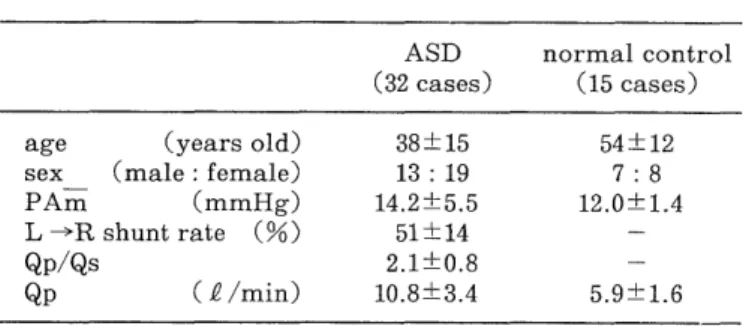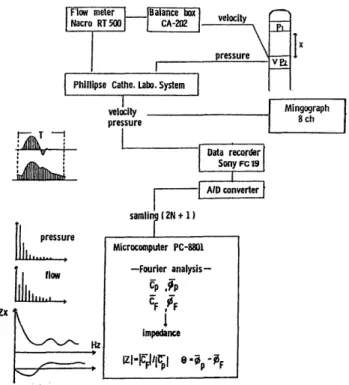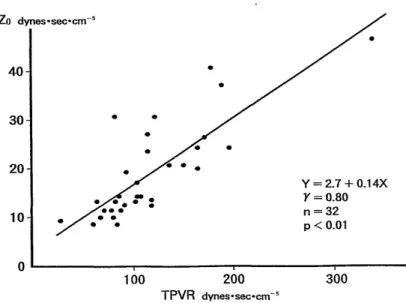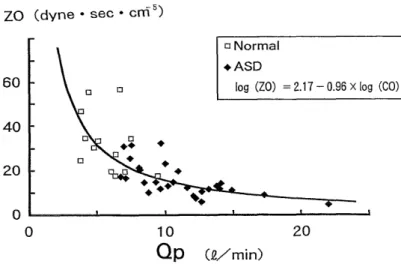Acta Med. Nagasaki 39: 107-113
Pulmonary Vascular Input Impedance in Patients with Atrial Septal Defect
Tadaki MATSUZAKI
The 2nd Department of Internal medicine, Nagasaki University School of Medicine
Pulmonary vascular input impedance was measured in adults with artial septal defect (ASD) to examine their pulmonary vessel lesions. Pulmonary vascular input imped- ance is a measure of the resistance of the pulmonary artery detected in the form of pulse wave. This test is more physio- logical than the conventional test of total pulmonary vascu- lar resistance. The following results were obtained.
1. The pattern of pulmonary vascular input impedance did not differ between the ASD group and the normal control group.
2. An increase in pulmonary artery blood folw volume (a major sign of ASD) resulted in a decrease in Z0 (the average of the pulsatile fraction of the pulmonary vascular input impedance), leading to suppressed elevation in the pulmo- nary artery pressure.
3. These features of pulmonary vascular input impedance remained unchanged when age advanced. Therefore, if Z0 is higher than its expected from the pulmonary blood flow volume, some accompanying lesions other than ASD may be responsible for such a change.
Introduction
According to the known natural history of atrial septal defect (ASD), patients with ASD show increased pulmo- nary vascular resistance, pulmonary regurgitation, re-
duced right ventricular output, right-to-left shunt, and atrial flutter or fibrillation in the latter half of their 20s
or in their 30s. Gradual progression of their pulmonary vascular lesions greatly affect the prognosis of these patients. To assess pulmonary vascular lesions in detail and to accurately assess the afterload at the time of blood ejection from the right ventricle in patients with ASD, it is essential to consider impedance which is an indicator of pulmonary vascular resistance expressed in the form of pulse wave. Pate et al.'), Berga et al.2) previously measured pulmonary vascular input impedance of the pulmonary vascular bed of dogs. Its measurement in clinical patients has seldom been performed because of the limitations imposed by the instruments needed for this measurement.
Due to recent advances in multi-sensor catheters, however, it is now relatively easy to measure pulse wave clinically.
In the present study, pulmonary vascular input impedance was measured in patients with ASD, using a multi-sensor catheter.
Subjects
The subjects were 32 patients with ASD who had under- gone cardiac catheterizatiori. In all patients, ASD was a secundum defect, without being accompanied by any other malformation. All patients were in a chronic stable state of ASD, without showing any sign of heart failure. Sinus rhythm was noted in all subjects. Table 1 shows the profiles of the subjects. Their age was 38 ± 15 years (4 cases between 10 and 19, 9 cases between 20 and 29, 4 cases between 30 and 39, 5 cases between 40 and 49, 8 cases between 50 and 59, and 2 cases between 60 and 69). There were 13 males and 19 females. The pulmonary artery pressure was often normal and averaged 14.2±5.49 mmHg.
The left-to-right shunt rate was 51--±--14 %. The ratio of system blood flow to pulmonary blood flow was 2.1 ± 0.77.
Pulmonary blood f low was 10.8 ± 3.361/min. The left-to- right shunt rate was over 10 % in 5 cases. The normal control group was composed of 15 individuals in whom a detailed examination at our department on the basis of suspicion of ischemic heart disease or other disease re- vealed no abnormalities. Informed consent was obtained from each patient before the study.
Tab. 1 Subjects
ASD normal control
(32 cases) (15 cases)
age (years old) 38±15 54±12
sex _ (male : female) 13 : 19 7 : 8
PAm (mmHg) 14.2±5.5 12.0±1.4
L - R shunt rate (%) 51±14 -
Qp/Qs 2.1±0.8 -
Qp (P /min) 10.8±3.4 5.9±1.6
(Values are mean ± SD)
Methods
1. Measurement of pulmonary vascular input impedance After the diagnosis was established by routine right cardiac catheterization, pulmonary vascular input imped- ance was measured (Fig. 1). The zero balance of flow velocity was calibrated in physiological saline. A multi- sensor catheter was subsequently inserted into the pulmo- nary atrery. A flow velocity sensor was placed at a point of the upper margin of the sinus trunci pulmonalis where the flow velocity wave was maximal. In this way, the pulmonary artery pressure and the flow velocity pattern were recorded simultaneously. A Millar VPC-684C multi- sensor catheter (2 pressures and 1 velocity) was used.
2. Analysis of impedance
On pressure-velocity curves, the impedance was ana- lyzed, according to the block diagram shown in Fig. 1. The flow meter used for this study was a Narcomatic RT500 (Narco Bio-System). The frequency response characteristic of this flow meter was approximately flat up to 30 Hz. A pressure-velocity curve was recorded together with an electrocardiogram, using a Mingograph 8Ch. The data were fed through a Logitec digitizer Mypad-A3 into a microcomputer, followed by Fourier analysis and calcula- tion of pulmonary vascular input impedance.
Fig. 1 Sampling and analytic method of pulmonary arterial input impedance.
T. Matsuzaki : ASD, Pulmonary vascular input impedance The first step of obtaining pulmonary vascular input impedance was Fourier transformation of the pulmonary artery pressure (P) and flow volume (F) curves, using the following equations
00




